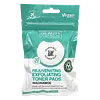What's inside
What's inside
 Key Ingredients
Key Ingredients

 Benefits
Benefits

 Concerns
Concerns

 Ingredients Side-by-side
Ingredients Side-by-side

Water
Skin ConditioningGlycerin
HumectantButylene Glycol
HumectantSalicylic Acid
MaskingCentella Asiatica Extract
CleansingSodium Hyaluronate
HumectantAsiaticoside
AntioxidantMadecassoside
AntioxidantMadecassic Acid
Skin ConditioningAsiatic Acid
Skin ConditioningPropolis Extract
Skin ConditioningArtemisia Annua Extract
MaskingHamamelis Virginiana Leaf Extract
Skin ConditioningSalix Alba Bark Extract
AstringentAllantoin
Skin ConditioningBeta-Glucan
Skin ConditioningTromethamine
BufferingDiethoxyethyl Succinate
SolventChlorphenesin
AntimicrobialPolyglyceryl-10 Laurate
Skin ConditioningPolyglyceryl-10 Myristate
Skin ConditioningEthylhexylglycerin
Skin ConditioningDextrin
AbsorbentGardenia Florida Fruit Extract
Skin ConditioningDisodium EDTA
Tocopherol
AntioxidantPropanediol
SolventBetaine
HumectantDipotassium Glycyrrhizate
Humectant1,2-Hexanediol
Skin ConditioningWater, Glycerin, Butylene Glycol, Salicylic Acid, Centella Asiatica Extract, Sodium Hyaluronate, Asiaticoside, Madecassoside, Madecassic Acid, Asiatic Acid, Propolis Extract, Artemisia Annua Extract, Hamamelis Virginiana Leaf Extract, Salix Alba Bark Extract, Allantoin, Beta-Glucan, Tromethamine, Diethoxyethyl Succinate, Chlorphenesin, Polyglyceryl-10 Laurate, Polyglyceryl-10 Myristate, Ethylhexylglycerin, Dextrin, Gardenia Florida Fruit Extract, Disodium EDTA, Tocopherol, Propanediol, Betaine, Dipotassium Glycyrrhizate, 1,2-Hexanediol
Water
Skin ConditioningNiacinamide
SmoothingLactic Acid
BufferingGlycerin
HumectantHamamelis Virginiana Water
AstringentPrunus Persica Extract
CleansingYeast Ferment Extract
Skin ConditioningGlycyrrhiza Uralensis Root Extract
Skin ConditioningSmilax Glabra Root Extract
Skin ConditioningSophora Flavescens Root Extract
AntioxidantHydrolyzed Rheum Officinale Root Extract
Skin ProtectingPropylene Glycol
Humectant1,2-Hexanediol
Skin ConditioningPEG-40 Hydrogenated Castor Oil
EmulsifyingParfum
MaskingAllantoin
Skin ConditioningEthylhexylglycerin
Skin ConditioningDehydroacetic Acid
PreservativeCetrimonium Bromide
AntimicrobialSodium Hydroxide
BufferingPhenoxyethanol
PreservativeWater, Niacinamide, Lactic Acid, Glycerin, Hamamelis Virginiana Water, Prunus Persica Extract, Yeast Ferment Extract, Glycyrrhiza Uralensis Root Extract, Smilax Glabra Root Extract, Sophora Flavescens Root Extract, Hydrolyzed Rheum Officinale Root Extract, Propylene Glycol, 1,2-Hexanediol, PEG-40 Hydrogenated Castor Oil, Parfum, Allantoin, Ethylhexylglycerin, Dehydroacetic Acid, Cetrimonium Bromide, Sodium Hydroxide, Phenoxyethanol
 Reviews
Reviews

Ingredients Explained
These ingredients are found in both products.
Ingredients higher up in an ingredient list are typically present in a larger amount.
1,2-Hexanediol is a synthetic liquid and another multi-functional powerhouse.
It is a:
- Humectant, drawing moisture into the skin
- Emollient, helping to soften skin
- Solvent, dispersing and stabilizing formulas
- Preservative booster, enhancing the antimicrobial activity of other preservatives
Allantoin is a soothing ingredient known for its protective and moisturizingg properties. Because of this, it is often added to products with strong active ingredients.
Studies show higher concentrations of this ingredient can promote wound healing.
Though it can be derived from the comfrey plant, allantoin is produced synthetically for cosmetic products to ensure purity.
Learn more about AllantoinEthylhexylglycerin (we can't pronounce this either) is commonly used as a preservative and skin softener. It is derived from glyceryl.
You might see Ethylhexylglycerin often paired with other preservatives such as phenoxyethanol. Ethylhexylglycerin has been found to increase the effectiveness of these other preservatives.
Glycerin is already naturally found in your skin. It helps moisturize and protect your skin.
A study from 2016 found glycerin to be more effective as a humectant than AHAs and hyaluronic acid.
As a humectant, it helps the skin stay hydrated by pulling moisture to your skin. The low molecular weight of glycerin allows it to pull moisture into the deeper layers of your skin.
Hydrated skin improves your skin barrier; Your skin barrier helps protect against irritants and bacteria.
Glycerin has also been found to have antimicrobial and antiviral properties. Due to these properties, glycerin is often used in wound and burn treatments.
In cosmetics, glycerin is usually derived from plants such as soybean or palm. However, it can also be sourced from animals, such as tallow or animal fat.
This ingredient is organic, colorless, odorless, and non-toxic.
Glycerin is the name for this ingredient in American English. British English uses Glycerol/Glycerine.
Learn more about GlycerinWater. It's the most common cosmetic ingredient of all. You'll usually see it at the top of ingredient lists, meaning that it makes up the largest part of the product.
So why is it so popular? Water most often acts as a solvent - this means that it helps dissolve other ingredients into the formulation.
You'll also recognize water as that liquid we all need to stay alive. If you see this, drink a glass of water. Stay hydrated!
Learn more about Water